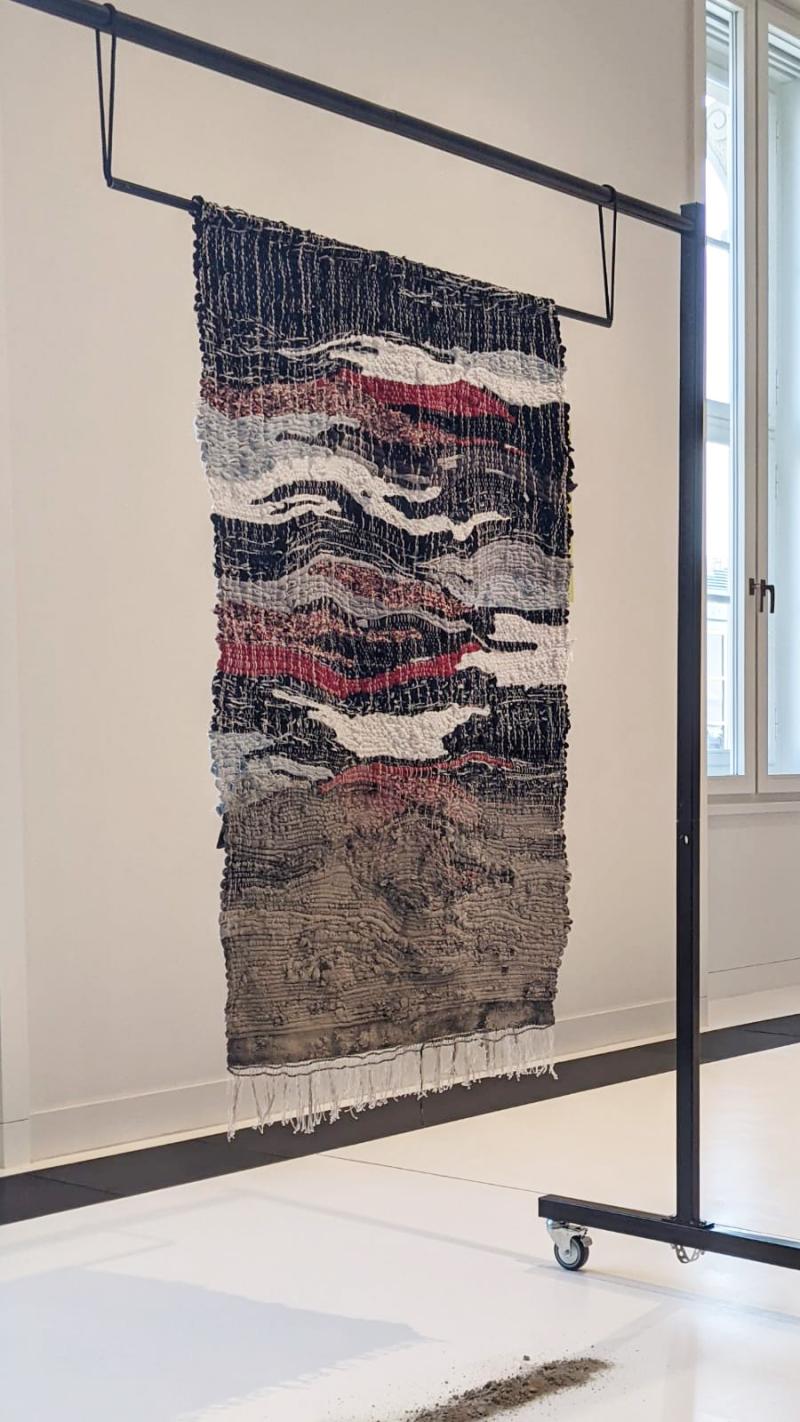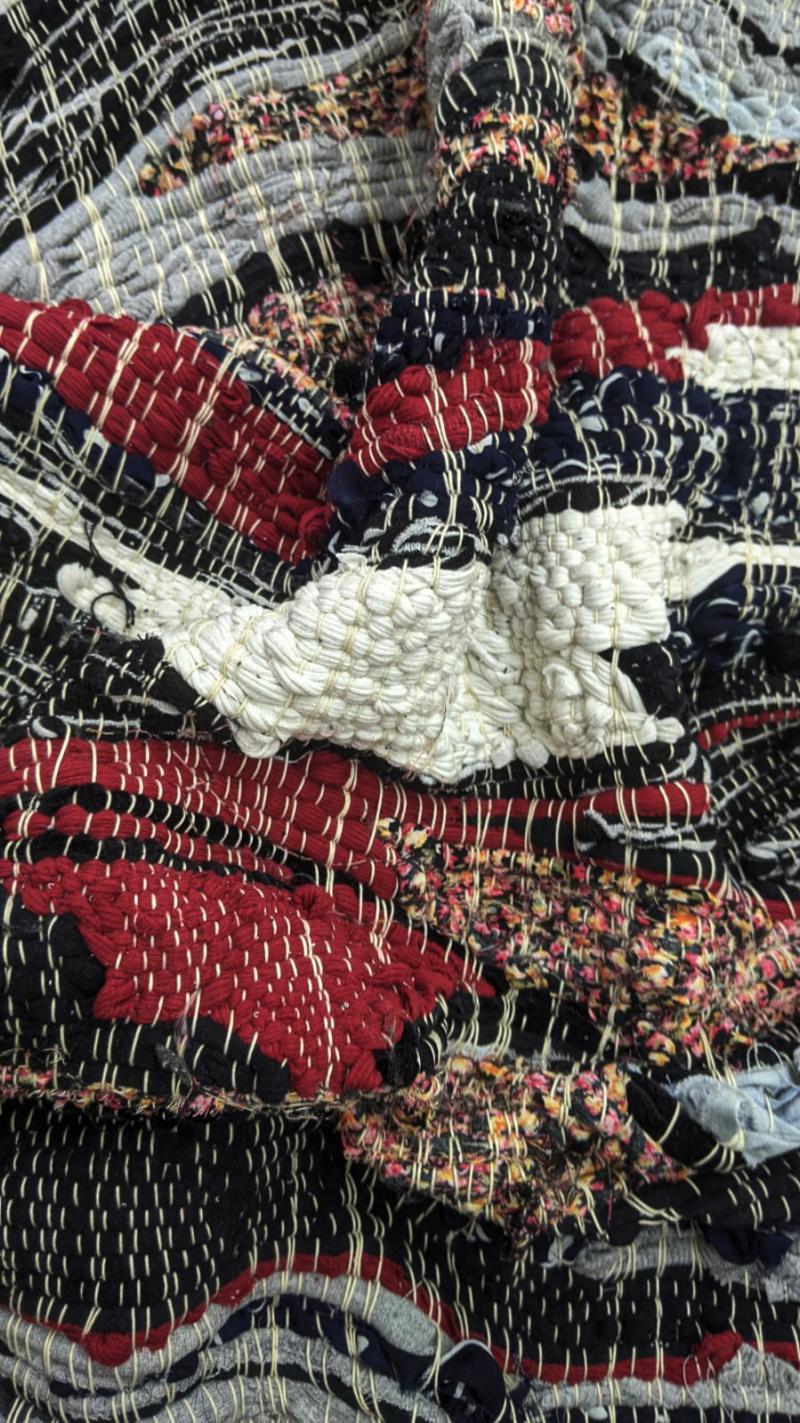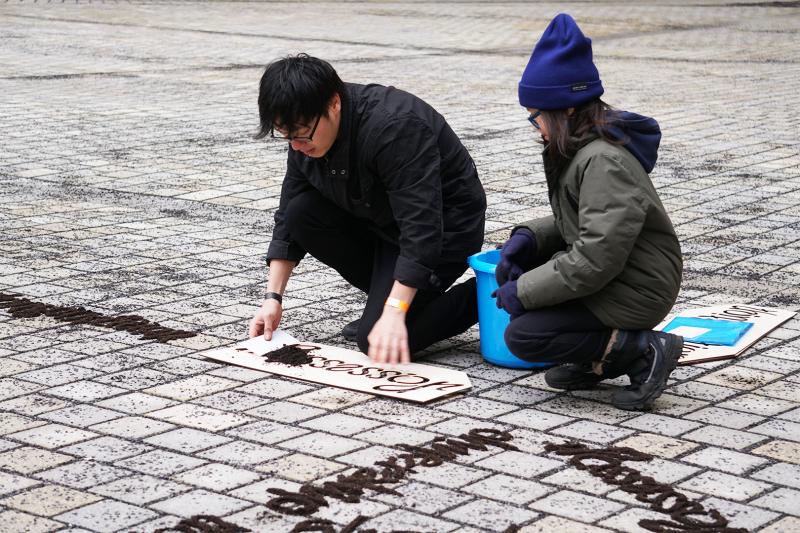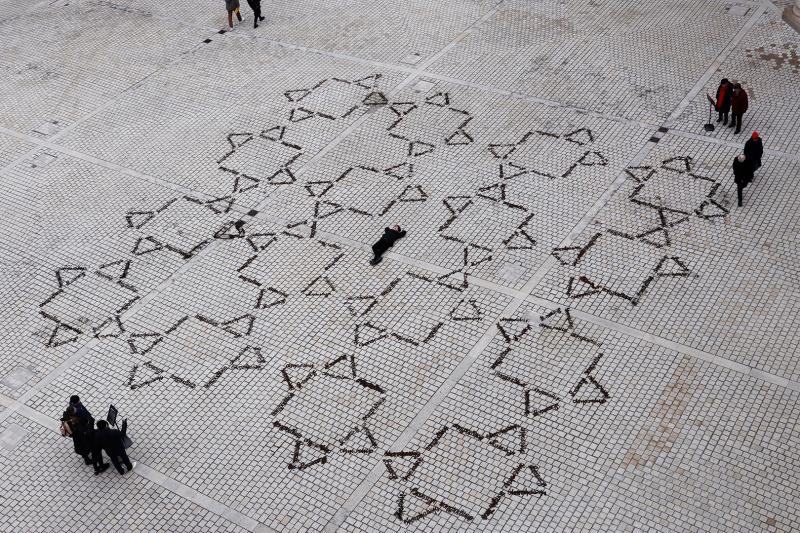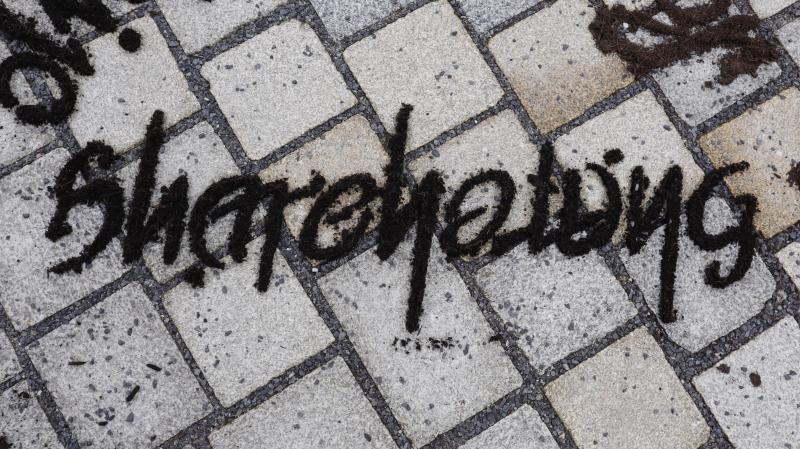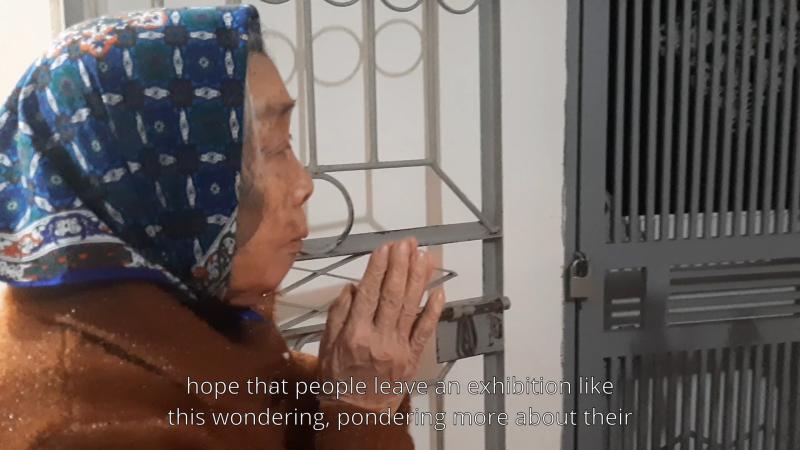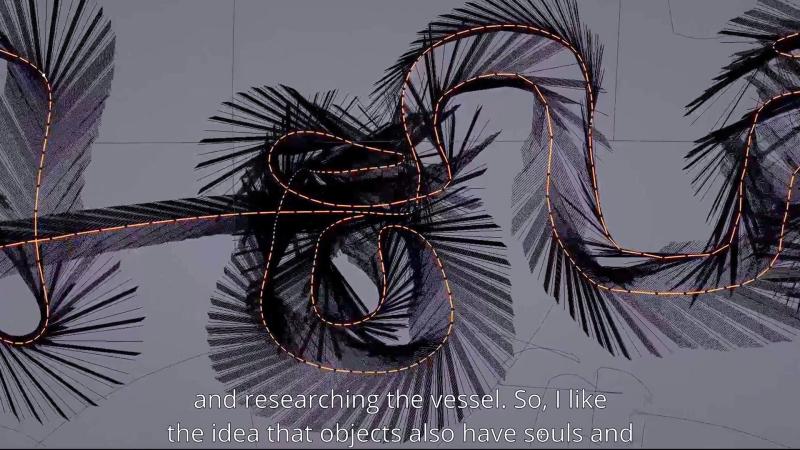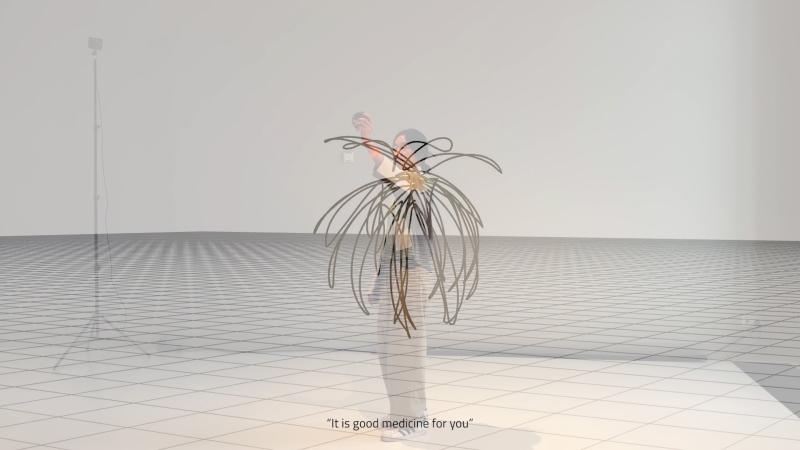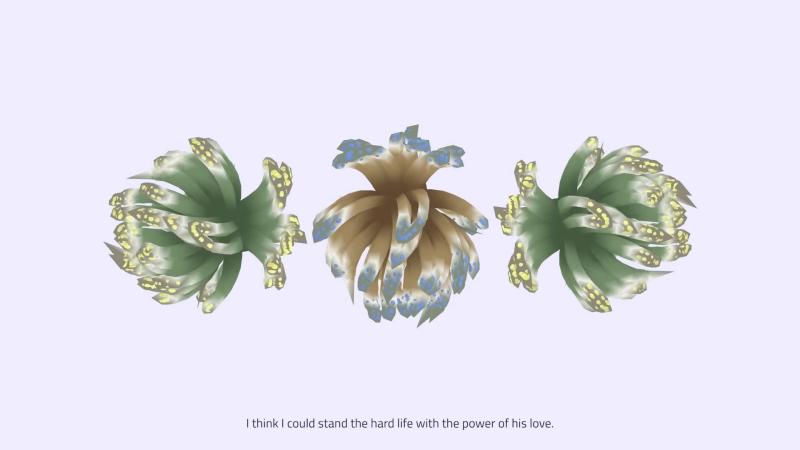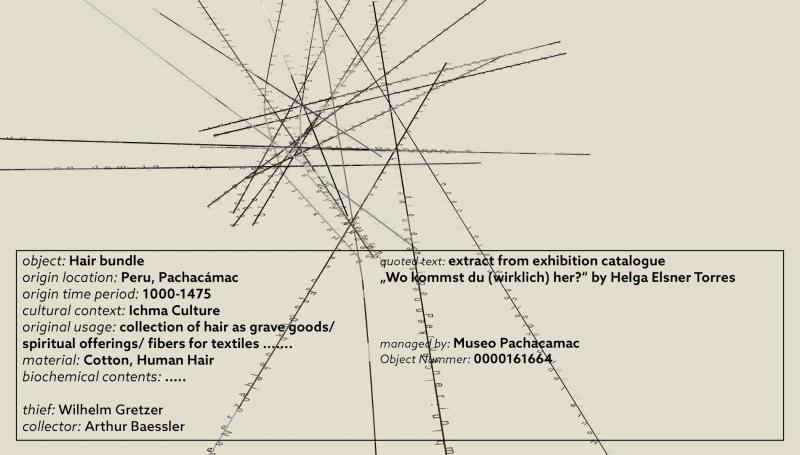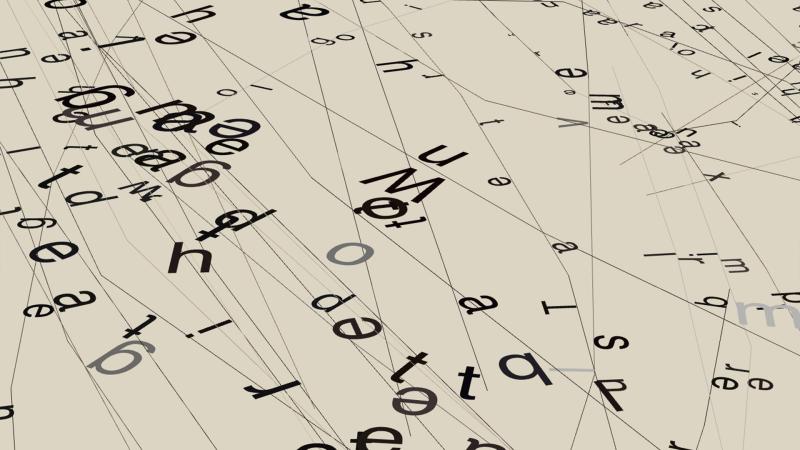Mingled Living Forces
“Mingled Living Forces” is a contemporary art intervention into the exhibition Leerstellen.Ausstellen at the Humboldt Forum presenting new works by students of the weißensee school of art and design. The intervention exhibition was developed in the context of the tandem seminars Colonial Presents: Artistic and Curatorial Interrogating led by Juana Awad and Zeichnen Farbe Fläche - Spatial Drawing led by Elaine Bonavia at the weißensee school of art and design berlin during the winter semester 22 /23 and summer semester 23.
How to reflect artistically on the evidence of colonial violence? How to intervene in an ethnological museum while the restitution of looted material culture takes place? How to draw speculative futures? Engaging with these questions, new artworks in a variety of media and formats including performance, installation, print, sculpture, painting, video and VR find their way into the ethnological museum.
The title of the intervention, is a quote from Suzanne Césaire’s Discontent of a Civilization 1 where she makes an urgent call to engender a new future. It is as an homage to her teachings that this intervention follows her text, which is both an analytical study of a present/past, and a poetic assertion for the possibility of something new. „Mingled Living Forces” refers to our coming together during these last months: a coming together of different peoples, texts and museum’s inhabitants, as well as a coming together of different processes, practices and methodologies. It is the mingling of these forces that are invoked in this project.
Beyond this summoning, this intervention has several conceptual entry points: it investigates the museum's raison d'être by engaging artistically with what it means to collect and to exhibit within a framework of domination; it approaches the museum’s perpetuation of colonial violences through material and sound interventions; and through spatial drawing, it engages with spatial technologies and artistic speculations as a means to inhabit a future museum once beings and material culture are returned.
The intervention presents these artistic works in an already inhabited space, entering into dialogue with the materials and documents exhibited in Leerstellen.Ausstellen – a temporary exhibition within the ethnological museum, whose concerns and approach to German colonial history we believe should be made permanent. The superimposition of “Mingled Living Forces” and Leerstellen.Ausstellen, with their meeting and collision points, is ultimately an experiment in spatial dialogue among objects, bodies, and exhibition practices.
With works by Imad Alfil, Bar Esh, Paulin Fichtner & Conrad Kunze, Quang Vinh Giang, Mohamad Halbouni & Aline Suter, Melis Kiran, Hami Mehr, Jasmin Sermonet, Inyeong Song, Raras Umaratih, Jelisa Weber
Imad Alfil “Wound”

Swirling and once more swirling around, in, into the oozing wound: the one looking straight at us, where everything is frozen, an indelible wound in what is left of humanity's consciousness. Swirling and once more swirling around, in, into.
Imad Alfil was born in 1990 in Syria, and lives in Germany since 2015. He currently studies Painting in the department of Fine Arts at the weißensee school of art and design. In his work he explores emotionality and intuition as gateways to the human psyche.
Bar Esh “Untangled” & “Sterilised Black”

The work “untangled” is a digital drawing experiment using body movement as a searching tool to relearn crafts, and reflect upon the body memory within the displayed “objects” in the museum. The repetitive movement of the drawer weaves their body into the drawing itself, until human flesh, stone and textile become inseparable. The movement of the body draws a line in the digital space, alienating it from its original environment; the line created is no longer a representative of the movement alone but an independent drawing. The dialog between the digital and the analog techniques speculates upon questions of memory, movement and stillness.


The textile work “Sterilised Black” uses textiles and concrete to explore the relation between displayed “objects”, the museum and its visitors, while raising questions regarding exhibiting and common restoration practices. The hand-woven fabric, made from clothes worn by the course participants during the study sessions, function as an archive of activity. Weighed down by the concrete, the textile is estranged from its primary materiality behaviour: it can no longer fulfil its own original purpose, but becomes an object that can solely exist in a display.
Bar Esh investigates through the use of textiles, texts and concrete, notions of public memory and remembrance culture, while questioning prevalent concepts of aesthetics. She studies Textile and Surface Design at the weißensee school of art and design, and works as a political educator in schools in Berlin.
Paulin Fichtner & Conrad Kunze “Geister der Ermordeten”

“Up at the window, [Karl] Liebknecht continues. Never again will a Hohenzoller enter this square.... [...] Peace and freedom are the central message of his speech, the rule of capitalism and imperialism is broken.”2
As early as “the end of February 1907, the socialist Karl Liebknecht castigated the crimes of the German Empire in what was then German Southwest Africa and other colonies as a colonial policy ‘which, under the pretense, Christianity and civilization or to preserve national honor, for the profit of capitalist colonial interests with a pious look proliferates and deceives, murders the defenseless and distresses them, scorches and burns the property of the defenseless, robs and plunders the belongings of the defenseless [. ..].’”3
We remember this time, when the century was still young and the hope for liberation from the rule of exploitative capitalism was alive. Overcoming its preconditions -colonialism, racism, sexism, imperialism, and classism- seemed truly attainable.
Paulin Fichtner uses artistic means to delve into social and political questions and to observe the unspoken, with the choice of artistic medium adapting to the subject matter and life situation. In recent years, Fichtner has been primarily focused on drawing while studying Fine Arts at the weißensee school of art and design.
Conrad Kunze is a historian and sociologist. In his book “Deutschland als Autobahn” (Germany as a Highway) he investigates the highs and lows of the 20th century. He is a lecturer at the Otto Suhr Institute of the Free University of Berlin and teaches imperialism theory, among others. He is an active member of the VVN-BdA (Vereinigung der Verfolgten des Naziregimes/Bund der Antifaschisten und Antifaschistinnen Berlin e. V.).
Quang Vinh Giang “Our Soil, Your Soil” & “Dear Humboldt Forum…”



In “Our Soil, Your Soil” four ambigrams of the words “thingification”, “ownership”, “shareholding” and “possession” are laid out to create a tessellation pattern on the courtyard of the Humboldt Forum. These concepts appear at various points throughout Aimeé Césaire’s “Discourse on Colonialism” and are pivoting moments with regards to the process of construction of the museum itself. The pattern is created with soil that will inevitably be carried away by those who step on it, emphasizing the desolation set in motion even by unintentional participants.
Performance Installation, 11.03., 9.–11.6., at Schlütterhof.


In “Dear Humboldt Forum…” a voice narrates a letter to the Humboldt Forum, in which an artist makes sense of what happens when reaching out to connect to the space of a museum that is the product of colonial history. Using drawing as an initial tool, the artist approaches the “ding” and reflects on its culture and meaning to its people. Overlayed thoughts, impressions and sensations, which were difficult to be expressed through the process of the courses giving rise to the work, are processed in the audiovisual letter. In the second part, the video presents a scenario where the objects in the ethnological museum are returned to their origins and are placed in an exhibition that combines 3D technology. If objects had souls, how could the technology of 3D, holograms visualize them? How can artists use 3D as a medium that could strengthen the spiritual sides of objects?
Quang Vinh Giang works primarily through the medium of sculpture. He currently experiments with ambigrams and notions of meaning creation, and is exploring digital 3D technology and the hybridization of analog and digital media, aiming at new formal possibilities. Giang also leads artistic creation workshops for children.
Mohamad Halbouni & Aline Suter “Bittersweet” & “Honest Floor Plan”
Similar to the structural power embedded in modernity, the installation “Bittersweet” starts its life span invisible and becomes more visible through the visitors’ interaction with it. It works like a trap, much like progress in the colonial context. The visitors are struck by the sticky sugar, which itself contains a laden history of colonialism. The sugar then moves with the visitors making them conscious of their steps as these become heavier and audible. The sugar also collects whatever has been carried by the visitors' shoes, and through this process of collecting it reveals itself in the space.
This unrealized work mimics the colonial practices behind the collections you see in the museum. It exposes the fragility of the museum and the need of total control within its infrastructure, which if realized would put the museum through a lot of undesired “safety issues”, the reason why the installation of the work was not permitted.
We think that performing coloniality continues to be a monopoly of white western institutions and their representatives, a privilege that is inaccessible to others.

The floor plan “Honest Floor Plan” offers an alternative way of mapping the museum. Instead of focusing on the architecture of the space, we seek to map discussions around the objects. We engage the space with our subjective drawings. Using our bodies as orientation tools, observing and noting down the visitors' comments, then mixing them with notes and quotes gathered throughout the class to challenge the supposedly neutral plan. The result is a new floor plan imagining a space where decolonial literature, the observations and comments of the visitors, as well as our own feelings and observations create a discussion missing from the official museum’s plan.
Mohamad Halbouni is a visual artist, working in performance, photography, installation, video games and short comic books. He studied Fine Arts at the Faculty of Fine Arts, Damascus University, and is currently studying at the weißensee school of art and design. Halbouni‘s work focuses on conflicts, contradictions and cultural identities, playing with and dismantling stereotypes of the middle eastern.
Aline Suter studies Costume and Stage Design at the weißensee school of art and design. Her work is primarily concerned with questions of justice in its social, political and environmental forms. Through experimentation with theater collectives and non-hierarchical working methods, she looks for ways to unsettle western traditions, narratives and power structures that underline most of today's global injustices.
Melis Kiran “could we return this memory?”

Textile fabric interwoven with collected reminiscences from everyday life.
Melis Kiran studies Textile and Surface Design at the weißensee school of art and design.
Hami Mehr “Plosives”

wave of the bits
the gloom
ly away
the Mono
moves into the space
''take me out
into the field
above the skin
give me a shape
give me a life
call me the beat
between blinks
give me a voice
give me a name
find me in the trace.
You lost somewhere
On the surface
above the skin.
I am the movement
I am the air
I am hidden in your breath''
Hami Mehr is an antidisciplinary artist from Tehran based in Berlin. Her main focus is on body politics and decolonizing the narrative of body, Mind and culture.
Jasmin Sermonet “Untitled”

Spatial drawing in used as a way to approach artifacts in display in the Humboldt Forum.
Jasmin Sermonet is completing her master in Textile and Surface Design at the weißensee school of art and design. Her focus lies on living textiles and fancy yarns.
Inyeong Song “Another Self”


An eye is the entry point for the encounter between the artist and one of the Sioux dolls exhibited at the Humboldt Forum. In this encounter Song imagines how with and through the doll, it would be possible to share with the ancestors. In an opening happening through empathic reception, the family history of the artist, with its legacy of colonialism, comes to light enabled through the spatial drawing investigation of the beads which construct the eye.
Inyeong Song is a material and surface designer, working with analog and digital technologies together. Her works are linked to a variety of traditional handicrafts and graphic works.
Raras Umaratih “A Question of Urgency”

What is the point of making and displaying anything here, when most of my friends and family that I grew up with, cannot even be here today?
What is the point of killing and hiding these Beings here - Beings experiencing a social and spiritual starvation - when most of the people who these histories belong to, cannot even be here today
Tapi aku memilih untuk hidup di luar sana, di antara, di seluk beluk dan serpihan.
Raras Umaratih: “In my artistic practice there are things that I can only do alone, and only do with others. Times where the distance created by aesthetics is a welcome moment to reflect, and times when this distance makes no sense.”
Jelisa Weber “Unraveling Hair”


The animation endeavours to recover the little that can be found about the Peruvian hair bundle on exhibition at Humboldt Forum, and constructs a digital object, which in its unraveling, is aware of the gaps and misinterpretations typical of ethnological museum’s collections. The sequence begins with a mimetic drawing of this human remain as it is displayed. It includes the partially wrong information that is given. The more data that is gathered, the more the hair reveals itself. But the information is unreliable and almost inexistent. So, the gaps come to the forefront; it is the omissions themselves that point to a history of violent extraction. Using digital means of parametric design to lead the form-finding process of the unfolding hair highlights these gaps and omissions.
Jelisa Weber was born and raised in Munich, next to the stonemason business of his family. Her closeness to material and craft led her to textiles and their techniques. During her studies of Textil and Surface Design at the weißensee school of art and design she discovered her fascination for systems, their rules and logics. Since then, her main focus has been on using programming to engage with the logics of behaviors.
-
1
See Césaire, Suzanne. “Discontent of a Civilization”, trans. Penelope Rosemont, in Surrealist Women: An International Anthology, ed. Penelope Rosemont, Austin: University of Texas Press, 1998, pp 129-133. ↑ -
2
Mythos der Revolution, Karl Liebknecht, das Berliner Schloss und der 9. November 1918, Dominik Juhnke, Judith Prokasky und Martin Sabrow, P 88. Translated with DeepL ↑ -
3
nd-aktuell, Verhöhnung statt Versöhnung, Sevim Dağdelen, https://www.nd-aktuell.de/artikel/1161654.postkolonialismus-verhoehnung-statt-versoehnung.html, last visited 24.02.2023 Translated with DeepL, Foto: U.S. National Archives and Records Administration, https://catalog.archives.gov/id/31477904, last visited 24.02.2023 ↑
